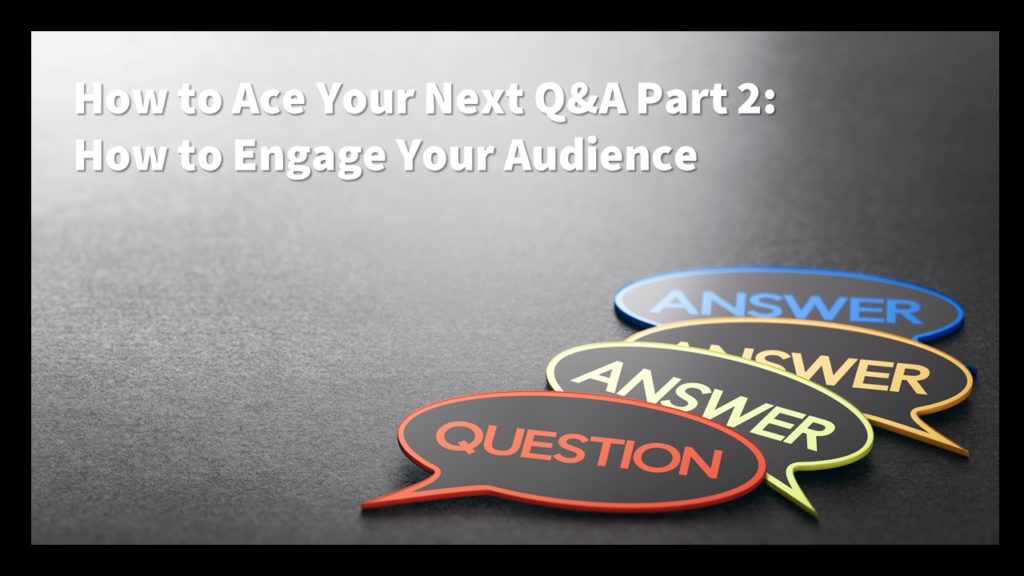How to Ace Your Next Q&A Part 2: How to Engage Your Audience
This post is part of a four-part series that will teach you how to prepare for and conduct effective, memorable, and meaningful question-and-answer sessions.
Your audience asks questions. You provide the answers. Done and done, right?
In reality, a Q&A session is not always so simple. What if your call for questions goes unheeded? What if an unclear question leads to an equally muddled response? What if, in your zeal to answer, your body language inadvertently sends a signal of impatience?

The following six techniques will help you keep your Q&A session on track.
1. Draw Out Your Audience
It’s not uncommon for a call for questions to be greeted with silence. The stillness may only last a few seconds, but for many presenters, it’s an eternity. So, they simply end the session, slink off, and question why they failed to capture the audience’s attention. Certainly, a lack of questions can signal the audience was bored or uninterested, but it can also mean something more productive – that they were processing your material.
You may need to draw out your audience to encourage interaction. The following techniques will help:
- Wait. Stand confidently and hold your gaze with the audience. Long silences are uncomfortable, and someone will likely fill the void.
- Broaden Your Request. Rather than just asking if anyone has a question, say, “What comments or questions do you have?”
- Pose a Question. Throw out a question about a topic you covered in your presentation. If you don’t get a bite, call on a few people.
- Ask for a Show of Hands. Ask a show-of-hands question, then ask one of the hand raisers to elaborate.
- Plan Ahead. Before your talk, enlist an audience member to serve as an ice breaker if silence greets your Q&A. Just be transparent when that hand goes up, so the audience doesn’t feel it is being manipulated (“Soledad and I spoke about something interesting prior to my talk. Soledad, would you pose that same question here for the group?”).
- End the Talk. If your efforts to draw out the audience don’t work, don’t despair. Confidently transition to your second close, offer your thanks, and make yourself available for discussion after the session ends.
2. Don’t Listen. Hear.
 There is a difference between simply listening and truly hearing what your audience has to say.
There is a difference between simply listening and truly hearing what your audience has to say.
When you truly hear, you slow down and fight the urge to act upon the belief that audiences expect an immediate response to every question. You prevent the overconfidence that assumes you know exactly where the audience member’s question is heading. If you give in to those urges, you might formulate a response too soon, leaving you flat-footed if the question takes an unexpected turn. You could miss their underlying concern. And the audience may resent what they perceive as your haste.
Slow down. Don’t begin answering the question in your head while the questioner is speaking.
Instead, free your mind of potential responses and try to identify the questioner’s main point, as well as deeper concerns that may remain unstated. For instance, an employee might ask a question about how much time a new procedure will take, but you suspect they’re really concerned that they will be expected to work longer hours to complete their work. When you answer, you can address the obvious concern and the one being left unsaid.
3. Understand the Question
Rambling statements often obscure main points, while vague questions may lead to imprecise responses. If you’re not certain what you’re being asked, use this three-step process to better understand:
- Ask for clarification. (“I’m sorry, I’m not sure I understand,” or “Would you please tell me a little more?”)
- Confirm you’ve gotten it right. (“Am I correct that you’re asking why we decided to close certain locations?”)
- Check for lingering confusion. If you still can’t figure out the intent of the question, ask the audience for help (“I’m sorry, I’m just not getting this. Can someone help me?”). Or, invite the questioner to meet one-on-one after your presentation.
4. Keep Your Answers Brief
The connection you have with your audience can quickly cool if the audience fears every question will unleash another long-winded answer. Keep the energy high by keeping your answers short. Avoid four-minute responses when a one-minute one would do. When you do so consistently, an occasional extended response will be forgiven.

5. Set the Right Tone
A centered and emotionally stable presenter projects competence and compassion. To project a genuine sense of confidence, you need to have the right mental mindset and exhibit the proper body language during your Q&A.
- Lock In. Give audience members your complete focus when taking questions. This isn’t the moment to take a sip of water or look down to reorganize your notes. Questioners should feel as if there’s nothing more important in your world at that moment than they are.
- Extend Your Hand. When calling on people, use an open palm, as if you are handing them an object. It’s a gesture that’s useful throughout your presentation but is especially helpful during the Q&A. It keeps you from using other gestures that may appear accusatory or aggressive, such as finger pointing or aiming your hand toward your audience palm down.
- Remain Open. Square your shoulders and face the audience. Keep your hands visible and arms uncrossed. If you’re not behind a lectern, walk subtly toward the questioner. Nod to show understanding.
- Maintain Eye Contact. For an answer that is less than, say, 15 seconds, you can hold your gaze solely with the questioner. For a longer response, make eye contact with the questioner at the beginning and end of your answer, and connect with others in between.
6. Repeat the Question
Although it is not always necessary, you may need to repeat an audience member’s question before you offer a response. Here are two times when doing so could be necessary:
- Your audience doesn’t have a microphone, making it difficult for everyone to hear the question.
- Your talk is being recorded. By restating the question, your answer makes sense during playback.
There’s no need to repeat the question or comment verbatim; just highlight the main point and respond.
Previous posts in this series:


